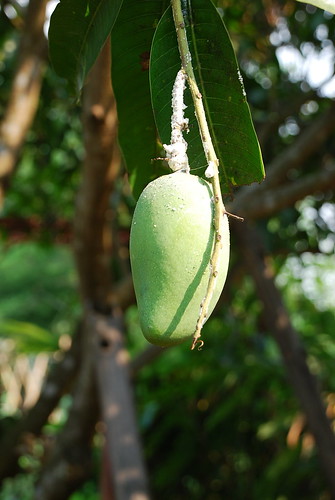There are dozens of cooking schools in Chiang Mai, but this is the oldest, and still reputedly one of the best. It was founded back in the early 90's by Sompon Nabnian and his wife, Elizabeth (who is English). Today they teach courses both at their office in the old city (just inside the Thapae Gate, one of Chiang Mai's five old gates) and at their house outside of town, where they have a dedicated teaching area. (Class sizes are larger at this school than at some of the others-- we had 28 students one day, which is the max-- but everyone still had a lot of fun and there were plenty of teachers to help out.)
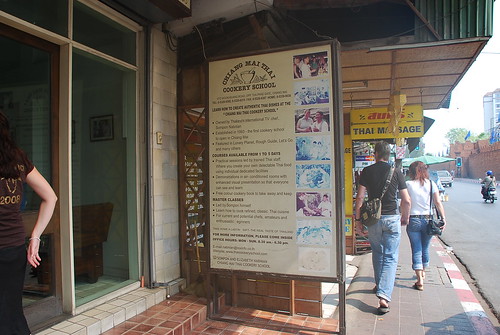
Wednesday started with a pickup at the hotel around 9:30 AM, and a trip to the school office in the center of town. There I and the other students signed in. On Wednesday, I was the only American out of about 15 people: the rest were from Australia, Britain and Germany. The course cost approximately 900 baht per day. The full "beginner" course runs for 5 days, but you can sign up for as many as you want, and each day is independent-- you don't have to start at the beginning of the cycle. I was lucky that my first day also happened to correspond to Course 1.
We then piled back into the vans to head to Sompon and Elizabeth's house outside of town. Once there, we picked our individual cooking stations on the porch (each with gas stove and a work surface with a cutting board and knife) and donned our snazzy aprons.
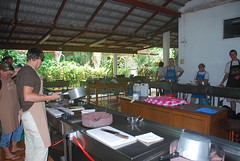

We then filed into the classroom where Khun "Ou", one of the assistants, proceeded with the morning's activity: a hands-on introduction to Thai ingredients. (Each course starts with a "metacooking" lesson like this, from how to pound curry pastes to how to carve vegetables into flower shapes or shop at a local market. On my second day we pounded our own curry pastes from scratch.) The classroom was well-equipped with a cooking area and a mirror above it that let us get a top-down view of what the instructor was doing.


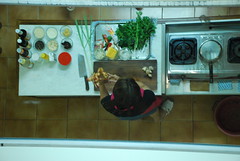
We then proceeded to the cooking. Each day we made six recipes, and for each recipe, the instructor demonstrated the process in the classroom before we filed outside to cook individual-sized portions for ourselves. While the demonstration covered the entire process, a lot of the prep work was done for us when it came to our actual cooking (for example, ingredients were already portioned out, shrimp were peeled and deveined, etc.) A lot of culinary purists would probably object to this, but I can definitely see the benefit to this approach. After we finished cooking each dish, we then carried it over to the tables to enjoy the fruits of our labor.
The first day's dishes were:
- Tom yam goong (hot and sour prawn soup)
- Tod mun pla (deep-fried fish cakes)
- Gaeng kheo wan gai (green curry with chicken)
- Pad thai (the famous Thai noodle dish)
- Larb gai (minced chicken salad)
- Tab tim grob ("crunchy rubies", or sweetened water chestnuts in coconut milk)
The second day's dishes were:
- Panaeng muu (panang curry with pork)
- Plaa nin laad prik bai horapa (deep-fried fish with chilli and sweet basil)
- Gaeng hanglay gai (Chiang Mai-style "dry" curry with chicken)
- Phad prio wan phak (sweet-and-sour vegetables)
- Yam woon sen (spicy glass noodle salad)
- Khao neow dam piak (black sticky rice with coconut milk)
I found each day's dishes to be a really nice blend of ingredients and cooking styles, so we got to try out a lot of different techniques. Overall I liked the second day's dishes better than the first, one of the reasons being that they provided more opportunity to tweak the spices and overall hotness of each dish for individual preferences (and I'm a wuss when it comes to chilies!)
I'll try to label the pictures on Flickr, but here are some snapshots:
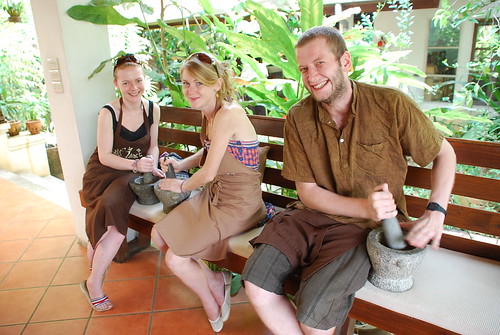
A trio of friends from England pound their curry pastes.
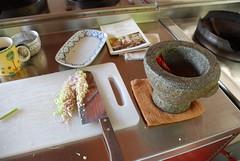
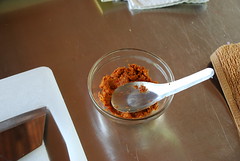
My own panang curry paste in progress, and finished.
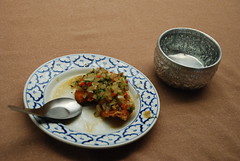

My fried fish and panang curry with pork. Very pretty and tasty, if I do say so myself!
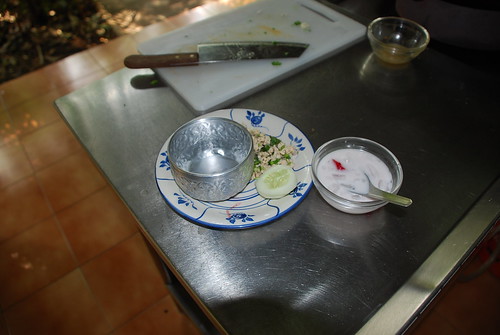
My larb gai and "crunchy rubies". The latter were really fun and easy to make-- you cut fresh water chestnuts into quarters, add a few drops of red food coloring (for the "rubies"), then dip them into tapioca flour and boil them until the tapioca attains a jellylike consistency. You then mix them with sugar syrup, coconut milk, and crushed ice, and voila! A nice, traditional, Thai dessert that is really tasty on a hot day.
(Random Cultural Note: Tab tim, "rubies", is also the Thai name for pomegranates, for obvious reasons!)
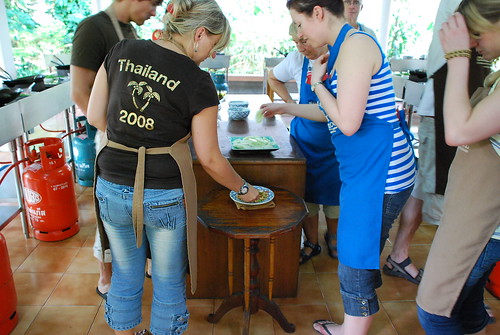
Students trying the official "sample" to know what their salad should taste like.
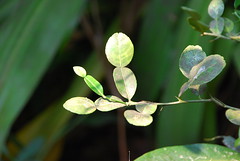
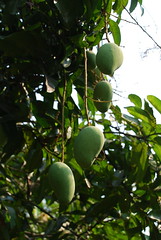
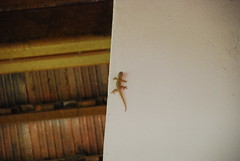
Behind the house is a nice garden where many fresh ingredients are grown, such as kaffir limes, mangoes, and geckoes.
All in all, this was a really fun experience and I'm glad I did it. It's not the most in-depth introduction to Thai cooking, but it was certainly enough for a newbie farang like me to gain some confidence! I plan to take my handy-dandy cookbook and inflict some new Thai recipes on Josh over the next few months.
I did not escape entirely unscathed from the experience, however, as I got hit in the head by a low-flying mango. No permanent harm done, fortunately.
